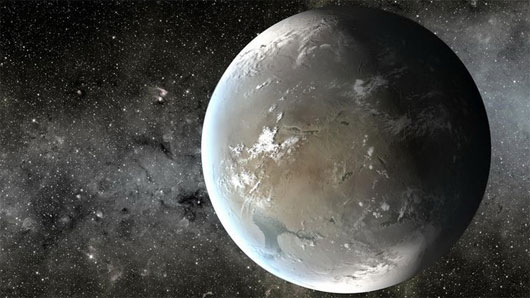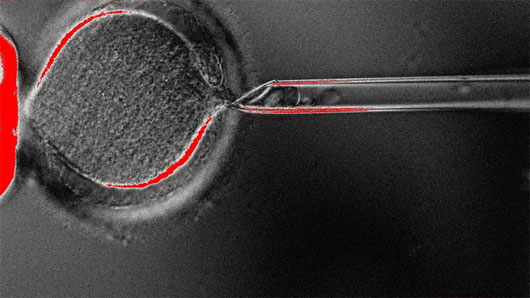5 most outstanding scientific discoveries in 2013
At least 100 billion stars in the galaxy; Human embryonic stem cell creation by cloning human skin cells; Voyager-1 crosses the solar system boundary; find a sign of a freshwater lake that once lived on Mars; Excavation of the complete skull skeleton - dating to about 1.8 million years old.
That's voted by National Geographic Magazine (USA).
1. Research by astronomers from the California Institute of Technology (USA) shows that the universe is "crowded" when they find at least 100 billion stars in the galaxy. Among them, about one-fifth of the stars have orbiting planets that closely resemble Earth and are said to be 'capable of survival' . One of them is the planet Kepler-62f - an Earth-sized rock planet - orbiting a star like the Sun in the constellation Celestial Planet located 1,200 light-years from Earth.

Planet Kepler-62f - (Photo: NASA / AMES / JPL-CALTECH)
2. Researchers from the Oregon University of Health and Science (USA) claim to have successfully created human embryonic stem cells by cloning human skin cells . They took skin cells from an adult's body and placed the cells of the cells inside the eggs they had removed. After that, they used electricity to stimulate eggs to develop into embryos. They concluded that stem cells can grow into any tissue in the body, so the replication technique could be used to develop replacement tissues and other organs for the treatment of diseases. , such as helping people recover damage to the heart or spinal cord.

Human cloning techniques to create human embryos - (Photo: OHSU PHOTOS)
3. Scientists from the US Aeronautics Agency (NASA) confirmed in September 2013 the Voyager-1 vessel became the first artificial object to cross the solar system boundary . 'This is an incredible event, for the first time human-made objects go into the interstellar space' - Donald Gurnett, lead author of the Voyager-1 spacecraft, works at the University of Iowa - talk to National Geographic. Voyager-1 left Earth on September 5, 1977, and was launched with the aim of surveying Jupiter, Saturn, Uranus and Neptune. The goal was completed in 1989. Scientists say 'twins' Voyager-2 will also soon enter the interstellar space.

Voyager-1 spacecraft illustration - (Photo: LLUSTRATION COURTESY CALTECH / NASA)
4. In 2013, NASA's Curious ship with Mars's adventurous mission was found to have found a sign of a freshwater lake that once lived on the red planet about 3.5 billion years . After analyzing the fine rock under the lake, they said that the smooth stone is neither salty nor acidic and contains the most nutrients carbon, hydrogen, oxygen, nitrogen and sulfur are eligible for the bacteria to grow.

Landing location of the Curious ship (blue dot) in the Gale Crater crater area on Mars - (Photo: NASA / JPL-CALTECH / ESA)
5 . Archaeologists unearthed a complete skull skeleton - known as Skull 5 , dating to about 1.8 million years old - in the Dmanisi, Georgia region. This finding makes history of human evolution 'possible to be rewritten'. The results of the Skull 5 study and comparison with the remains of four other human ancestors unearthed at the same site suggest that this is one of the first members of the Homo breed including Homo habilis, Homo. rudolfensis and Homo erectus. Although they have many different characteristics, all Homo races belong to the same species, contrary to previous beliefs that the different characteristics of Homo fossils suggest that they are different strains of humans. .

Skull 5 - (Photo: GEORGIAN NATIONAL MUSEUM)
- 10 outstanding scientific discoveries in 2008
- 7 great scientific discoveries thanks to dreams
- 10 outstanding scientific events in 2017
- New method of dating: One of 10 outstanding discoveries of the year
- The American newspaper honors the study of Vietnamese mathematicians
- Outstanding scientific findings in 2015
- Looking back at the outstanding scientific events in 2015
- UNESCO honors five outstanding female scientists
- The accidental scientific discovery possible
- Launching a science application prize worth $ 30,000
- New discoveries about the human body (Part 2)
- 10 outstanding science and technology events 2014
 Vietnam 5th Asian champion on fuel-efficient vehicles
Vietnam 5th Asian champion on fuel-efficient vehicles We can read all NASA studies completely free of charge
We can read all NASA studies completely free of charge Singer and songwriter Bob Dylan won the 2016 Nobel Prize for Literature
Singer and songwriter Bob Dylan won the 2016 Nobel Prize for Literature Scientific revolution in Asia
Scientific revolution in Asia